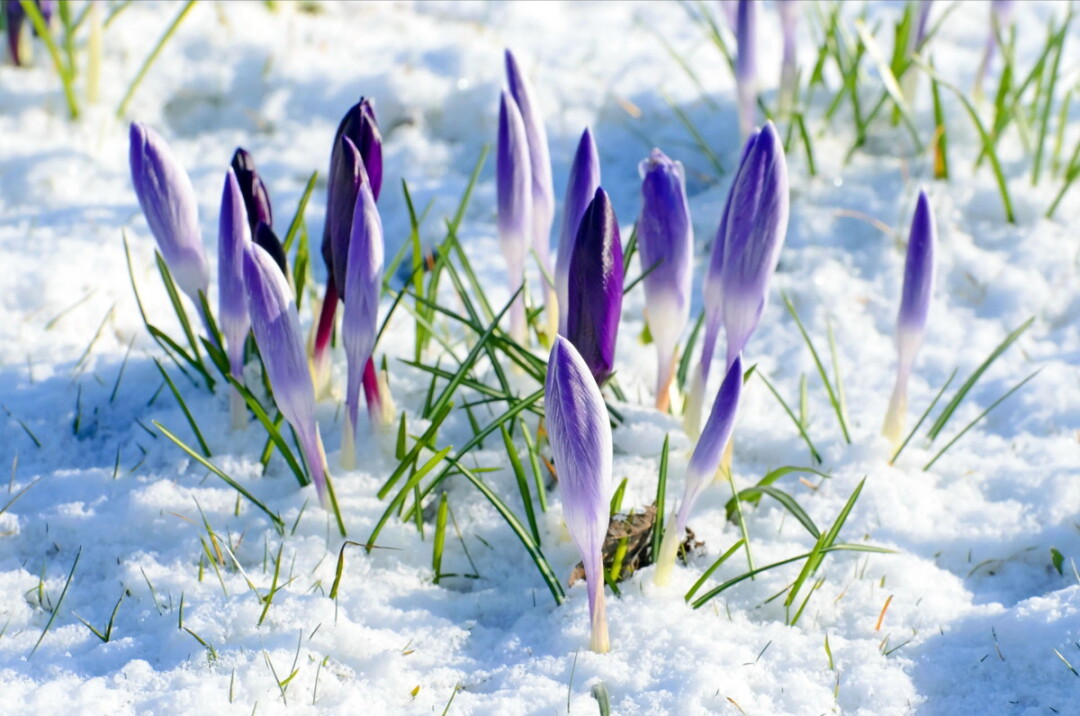Crocuses in Snow
in Wisconsin, the arrival of spring can be a slow process

Sometime around Easter, the cherry trees lining both sides of my mother’s street in Maryland create a gauzy cathedral, easing her from winter into summer. When I was little, I would waltz down that aisle, happy that the short ineffectual winter was over. By then the crocuses had come and gone, their banner taken up by daffodils and tulips, to be followed by innumerable azaleas, lilacs, and lilies throwing colorful confetti over the suburban lawns, all before May Day.
Now I live in Wisconsin, where the brown spring does not remind one of a celebration but rather of an old bachelor thawing old meat, twisted with freezer burn. Yet on a day in early March, my children and I rejoice even in brown as the melting snow finally reveals a glimpse of earth. My children, with their thick Wisconsin blood, throw off their hats and drink in the sunshine.
Now I live in Wisconsin, where the brown spring does not remind one of a celebration but rather of an old bachelor thawing old meat, twisted with freezer burn.
A couple of weeks later, the snow recedes enough to reveal the dull chestnut of my garden. Although I long for cherry blossoms, I know the best I can expect are crocuses. I find one immediately, then search for any other survivors, but it looks grim. I had planted them when we first moved here, hoping to bring the spring celebration to my front yard, but every year fewer return.
The first morning of spring: cold but sunny. “Nice day,” a man calls, oddly sincere as he scrapes frost from his windshield. Odder still, I find I agree. In Maryland, temperatures like this are rare, only happening in the dead of winter, not on the cusp of spring. Were I back east, I would be huddled inside, afraid to venture out lest my car skid on black ice. We feared black ice the way your ancestors feared the wolves of the Northwoods.
On St. Patrick’s Day, I walk my children over the university footbridge. The silty river has flooded, sighing against the bridge pillars, careless after imprisonment. A metal rowboat is wrapped around a pillar, battered tight against the concrete by the strong current. My hat is thrown into the water by a gust of wind, and it rushes downstream. “You must be careful when the river gets this high,” I caution my son. “It’s very dangerous.” He’s only 4, so he nods. “Dangerous.” He clutches my hand tighter.
The next week, we drive south to visit a newborn calf. He startles as my kids dart around the dairy barn, so we tour the farmer’s property. Her creek, normally demure, grew mighty during the flood and destroyed a small bridge. Shards of cinder blocks litter the area. My son pitches a few into the sheepish creek that once again aspires only to flit about our ankles.
Overnight, more crocuses appear in my garden, only to be smothered by a late snow. Flakes swirl in front of my house while a thousand miles away petals swirl in front of my mother’s. She shovels them off the walk so neighbors won’t slip in the rain. Each step crushes petals and releases the strong perfume of dying blossoms. I don’t bother to shovel. My flakes will melt by tomorrow; hers will linger for days.
By April, the crocuses have given up, and the daffodils have not yet come, so we search a pond for frogs. A few of the males already sing out for mates. Every year I wonder how they survive the winter, the freeze and refreeze of noncommittal springs.
Our spring is not an easy passage. Here, rivers flood. Children are sucked into icy mud puddles. Frogs that didn’t survive the winter thaw and rot, sending out the stench of long-postponed decay rather than ballads. Here, Persephone has a steeper climb from her tomb, all the more alive once she finally emerges for being all the more dead, and she is not alone. We journey with her, and once above ground we rejoice in the smallest blessings: frog songs, the brown earth, a lonely crocus emerging from the snow.


















